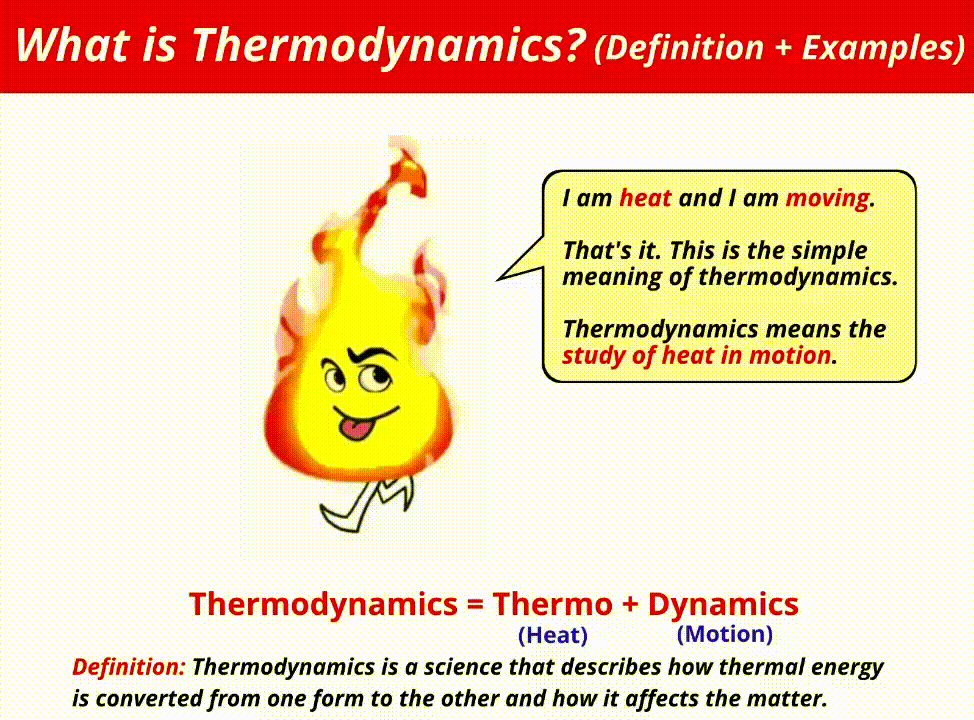
Hey there !!!
Just look at me. I am heat and I am moving.
That’s it. This is the simple meaning of thermodynamics.
Thermodynamics means the study of heat in motion. Let me explain you thermodynamics in brief (it’s easy, trust me)

Have you ever wondered from where does the word Thermodynamics come from?
Thermodynamics is derived from two Greek words “thermes” and “dynamikos”.
- “Thermes” means heat and
- “Dynamikos” is related to the study of motion (dynamics)
Thus, in a simple way thermodynamics is nothing but a study of heat in motion (or heat movement or heat flow)
Let me give you some examples to give you a feel of the concept.
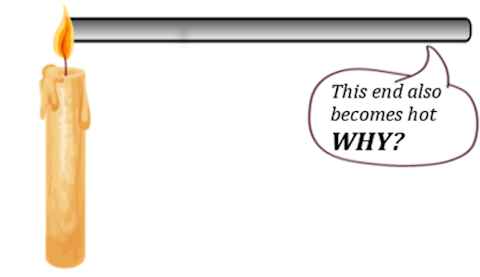
Have you ever experienced this?
When one end of the metallic rod is heated, the other end also gets heated within a few minutes. This is because of heat flow from one point to another in a metallic rod.
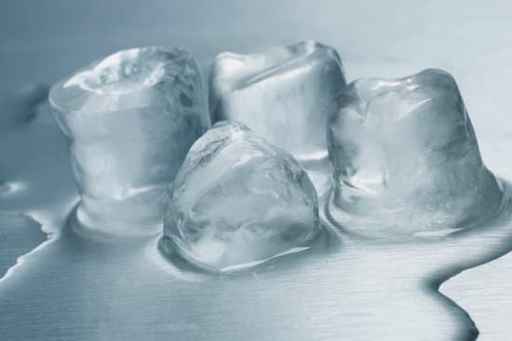
What happens when you keep the ice on a table? This ice will start melting right !!
Why does this happen? (Stay tuned, I’ll answer you just in few seconds)
Let’s move to another example.
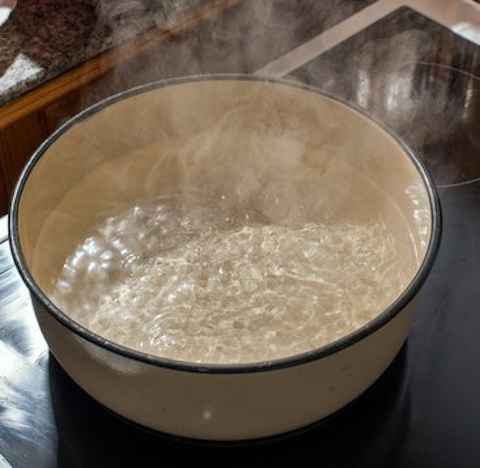
What happens when you keep on applying heat to the water?
The water gets heated and finally, it starts to boil. This is related to thermodynamics.
Enjoying the examples? Keep reading.
Let’s see one more example here.

What happens when you keep the hot coffee in the room?
It will cool down gradually and achieves room temperature.
All these things occur due to thermodynamics.
Now let’s frame the definition of thermodynamics
How will you define thermodynamics?
The definition of thermodynamics can be stated as;
“Thermodynamics is a science that describes how thermal energy is converted from one form to the other and how it affects the matter.”
But there are some laws that are responsible for all the processes occurring in these above examples. These thermodynamics laws are given below:
- Zeroth law of thermodynamics
- First law of thermodynamics
- Second law of thermodynamics and
- Third law of thermodynamics
Don’t worry, I will give you some overview of these laws later in this article, so keep reading till the end or kindly check this table of contents and skip directly to your interested topic. (All of your doubts will be cleared for sure)
Contents
What is a temperature?
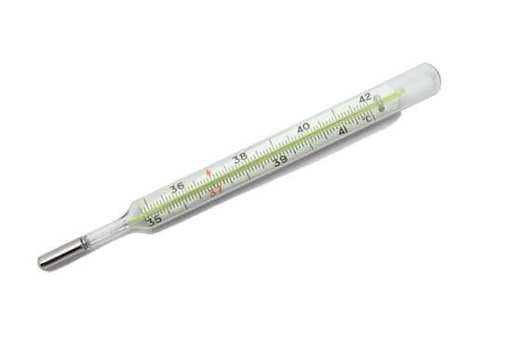
If we keep on hitting the nail with hammer, then it becomes little bit warm. Why?

What happens when you rub your hands together?

Yes you are right. Your hands will become warm. But why such things happen?
This happens because when we hit the nail with a hammer or we rub our hands, the molecules start to move fast. This increases the kinetic energy of the molecules and because of this we feel our hand warmer when they are rubbed together.
In general, the warmer body possesses more kinetic energy and the colder body possesses less kinetic energy.
What will be the definition of temperature in thermodynamics?
We have seen in the above examples that, if kinetic energy is more, then the body is warm (or hot) and if kinetic energy is less, then the body will be cold.
Thus,
Temperature is a measurement of the average kinetic energy of the molecules in any object.
Temperature can also be defined as a degree of hotness or coldness of an object.
There are many devices used for measuring temperature.
Here I have listed few temperature measuring devices.
- Liquid in glass thermometer
- Radiation thermometry
- Constant volume gas thermometer
- Constant pressure gas thermometer
- Thermocouple
- Silicon diode
- Thermistors
- Bimetallic device
- Bulb and capillary sensors
- Pyrometer
- Resistance temperature detector (RTD)
- Sealed bellows, etc
The value of temperature is indicated using temperature scales like
- Fahrenheit scale (°F)
- Celsius scale (°C) and
- Kelvin scale (K)
Also see: Zeroth law of thermodynamics and temperature
Heat (you will love this concept)
I will explain you the concept of heat in thermodynamics with a very simple example. Keep reading.
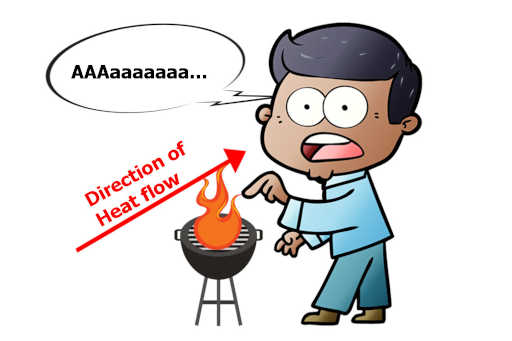
This boy touched the hot stove by mistake and feels the stove very hot.
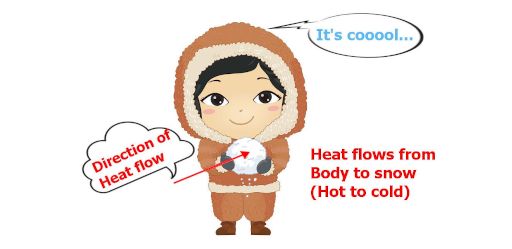
But this boy is feeling cold on holding the ice in his hand.
Let me explain to you the phenomenon which occurs over here and you will surely understand the concept of heat.
When you touch the stove, the thermal energy enters your hand because the stove is warmer than your hand.
But when you touch a piece of ice, then the case is reversed. Your hand is warmer than ice. So thermal energy will pass out of your hand.
What have you observed from these two examples?
- Heat always flows from higher temperature to lower temperature.
- Heat flows due to temperature differences between the two objects.
Now it’s time to frame the definition from these concepts.
Definition of heat:
Heat is defined as a flow of thermal energy due to differences in temperatures.
Heat is simply thermal energy in transit.
Very easy, isn’t it?
Now, let me ask you a simple question.
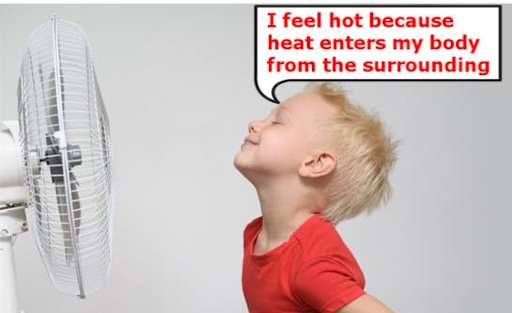
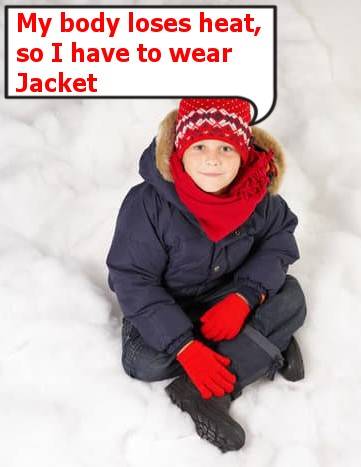
Why you wear sweater during winter and not during summer?
Let us discuss this with some thermodynamic approach.
You feel hot in summer season because the heat enters your body from the surrounding.
While in winter season, what do you think? Something like “Cold” enters to your body?
No, it is not so.
Actually, your body loses heat to the surrounding (because in winter, your body is warmer than surrounding. Remember, heat always flows from higher temperature to lower temperature)
This is the reason, why you feel cold in winter season.
And in order to avoid this heat loss from the body, we have to wear sweater in winter.
In other words, sweater avoids the flow of heat from the body to the surrounding.
Heat is a type of energy, so it’s SI unit is the same as the unit of energy i.e Joule. It is denoted by “J”. In British Thermal Unit (BTU), the unit of heat is often used as “calorie”. It is denoted by “C”.
Remember that,
1 calorie = 4.18 Joules
So finally I want to summarize the difference between temperature and heat.
| Temperature | Heat |
|---|---|
| Temperature can also be defined as a degree of hotness or coldness of an object. | Heat is defined as a flow of thermal energy due to differences in temperatures. |
| Temperature is measured in Fahrenheit (°F), Celsius (°C) and Kelvin (K). | Heat is measured in Joules (J) or calorie. |
Concept of thermodynamic system and surrounding
Let me explain you thermodynamic system, surrounding and boundary with a simple example.
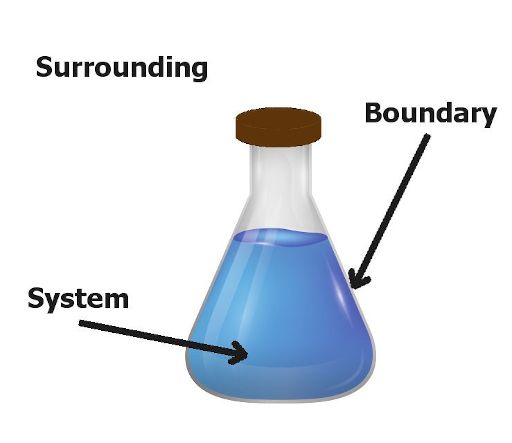
What do you mean by surrounding or environment?
What do you mean by boundary?
What is universe?
Here is the answer.
Well, as shown in above picture, the inside part of the flask is known as system.
The region outside the flask is known as surrounding.
And the imaginary line separating th flask and surrounding is known as boundary.
And finally, the combination of the flask as well as surroundings is called the universe. (Just like the combination of stars, planets, satellites, etc is called a universe)
Now let me give you a proper definition of this terms.
Thermodynamic system: The system is defined as a part of the universe that is chosen for the thermodynamic study.
Surrounding: The region outside the system is known as surrounding.
Boundary: The actual or imaginary line which separates the system and surrounding is known as boundary (see figure).
Universe: The combination of the system and the surroundings together is usually referred to as the universe.
Yes this is simple!!!
Now let me discuss with you something about the types of thermodynamic system.
What are the types of thermodynamic system?
There are three main types of system.
Open system
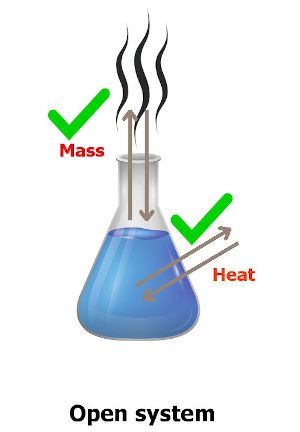
Don’t worry if you haven’t understood anything from the above image. I’ll explain to you in a simple way.
As seen in the image, the flask is open. So the mass of water can be transferred through the flask. Right!!
Same way the heat is also transferred from the walls of the flask.
Thus the system in which heat transfer as well as mass transfer takes place with the surroundings is called an open system.
Closed system

Have you understood something from image?
If not, don’t worry.
See, in a closed system, the flask is closed. So the mass of water can not be transferred through the flask. But heat transfer can occur through the walls of the flask. Got it?
Thus the system in which only heat energy is exchanged with the surroundings is called a closed system.
Isolated system
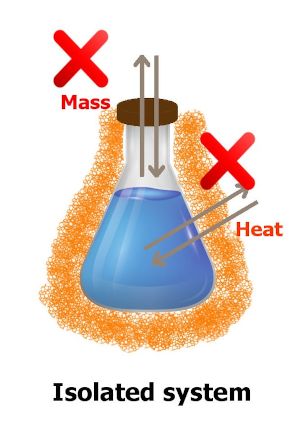
Now this is very simple!!
In this type of thermodynamic system, neither mass transfer takes place nor heat transfer takes place. Such a system is known as an isolated system.
You might have observed that the hot coffee remains hot and cold coffee remains cold in a thermos flask.
So thermos flask is a very good example of isolated system.
Do you know why I mentioned the example over here?
I have mentioned some good examples in this entire article so that it is easy for you to understand as well as you can also answer the questions easily in your oral and written exams.
Summary:
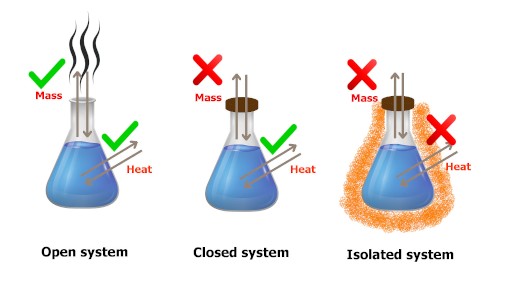
| Open system | Closed system | Isolated system |
| Heat (Yes) | Heat (Yes) | Heat (No) |
| Mass (Yes) | Mass (No) | Mass (No) |
What is heat transfer? How heat transfer occurs?
In our day to day activities, we see heat flow taking place surrounding us.
Let us understand with some examples.
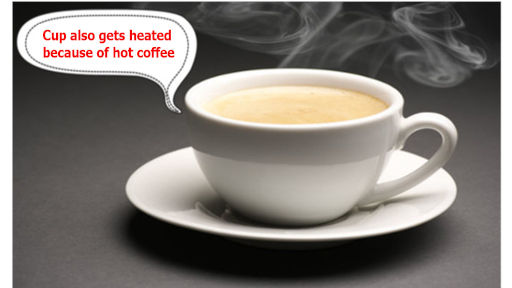
When hot coffee is poured into a cup, the cup also gets hot after few minutes. Why?
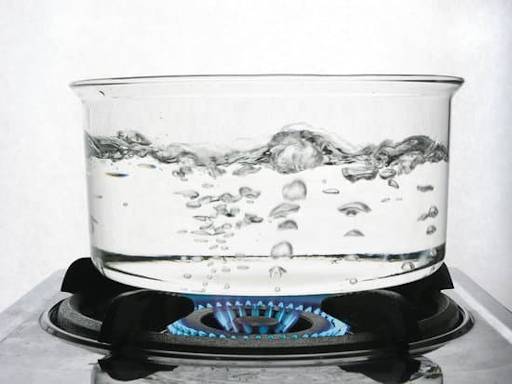
Why all of this water gets heated just by heating the bottom of the container?
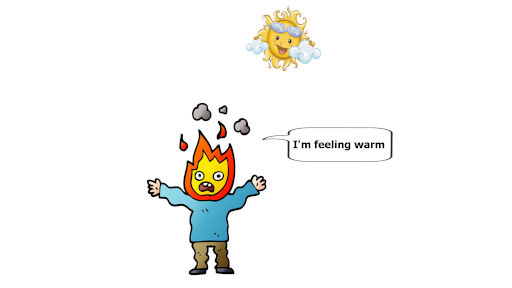
When I use to stay outside my home in summer noon, I feel warm. Why?
All these examples shows the transfer of heat from one point to other.
In the first example, you can see that cup also gets heated when hot coffee is poured into it. This happens because the heat is transferred from the inner side of the cup to the outer side of the cup.
In general we can say that this occurs due to direct contact of cup with the hot coffee. In thermodynamics, this phenomenon is termed as conduction.
Remember the below sentence for conduction.
Conduction: Energy is transferred by direct contact.
Keep reading. Amazing examples are on the way!!
Now, in the second example we see that entire water gets heated up just by heating the bottom of the container.
How this happens?
This occurs because the heat energy is transferred from the bottom layer of water to the top layer of water. And this heat transfer takes place due to the motion of water molecules.
In thermodynamics, this phenomenon is termed as convection.
Remember the below sentence for convection.
Convection: The energy is transferred due to motion of molecules.
Now, in the third example I told you that we feel warm when we use to stay outside the house in summer noon.
Well, we are not in physical contact with the sun. Even though we feel warm.
This occurs due to electromagnetic waves coming from the sun to the earth.
This is termed as radiation heat transfer in thermodynamics.
Remember the below sentence for radiation.
Radiation: The energy is transferred by electromagnetic radiation.
Let me summarize conduction, convection and radiation in a single example. This will help you understand the modes of heat transfer in a better way.
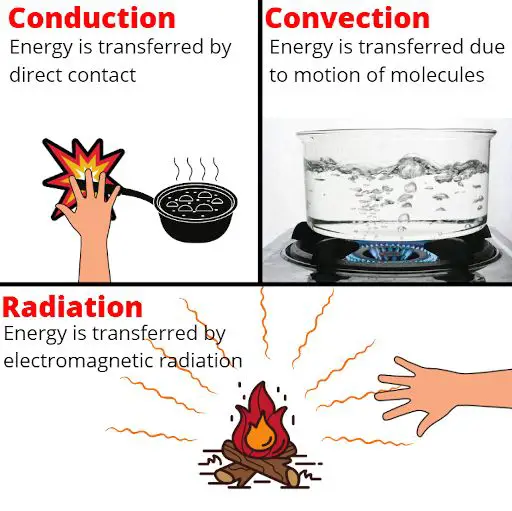
What is Thermal Equilibrium?
I will keep this simple.
Let’s take an example for better understanding, and later on I will explain to you the definition of thermal equilibrium.
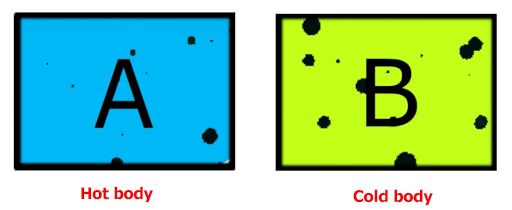
Consider one body at higher temperature and other body at lower temperature.
Let say the temperature of hot body is 80 °C and the temperature of cold body is 20 °C.

Now what will happen when we bring both the body in contact with each other?
Did you remember the concept of heat transfer which we discussed earlier in this article?
Yes, the heat transfer will start now when both the bodies will be in contact with each other.
The heat will start to flow from a higher temperature body to a lower temperature body. (Remember heat always flows from higher temperature to lower temperature)
In other words, we can say that a hot body becomes cold and cold body becomes hot. Or else we can say that hot body loses heat while cold body gains heat.
After some time, the temperature of both the bodies will be equal. Let say 50 °C.
After achieving this stage, there will be no heat transfer between the bodies. This stage is called thermal equilibrium.
Thermal equilibrium:
“The condition under which two objects in physical contact with each other exchanges no heat energy is termed as thermal equilibrium. During this condition, the temperature of both the bodies remains the same”
Just like thermal equilibrium, let me tell you something about mechanical equilibrium and chemical equilibrium.
Mechanical equilibrium:
“A system is said to be in mechanical equilibrium if the net force acting on the system is zero”
For example, if the pressure force inside the system is the same at all the points and does not change with time, then the system is said to be in mechanical equilibrium.
Chemical equilibrium:
“A system is said to be in chemical equilibrium if it’s chemical composition does not change with time and no chemical reaction takes place in the system”
Or
“A reaction is said to be in chemical equilibrium if the rate of forward reaction and rate of the reverse reaction is equal”
Now what is thermodynamic equilibrium?
Its very simple, it is a combination of all these above mentioned three equilibriums.
Thermodynamic equilibrium:
“Two systems are said to be in thermodynamic equilibrium when they are in thermal, mechanical and chemical equilibrium with each other”
Read more about: Thermodynamic equilibrium (With examples)
Zeroth law of thermodynamics
(Note: For detailed explanation on Zeroth law, refer this article: Zeroth law of thermodynamics with examples)
When I was student, I was wandering why it is named “Zeroth”, why not first, second, third, etc???
It should be like first law, second law, third law, etc… But it is named zero. Why?
Are you having the same question?
Don’t worry, I will answer your query.
The first law, second law and third law were already discovered earlier.
Later in the year 1931, Fowler realized that thermal equilibrium is a very important phenomenon and it should be defined before first law. This law was very important which defines the fundamental term “Temperature”, and according to him, this law should be kept first for proper understanding of thermodynamics laws.
But already so many books were published with the first law, second law and third law. So changing the numbers of these laws can create a lot of confusion. Thus he was forced to adopt the number “zero” for his law. And finally this law was named “zeroth law of thermodynamics”.
Now let us understand zeroth law of thermodynamics.
Consider three bodies A, B and C.
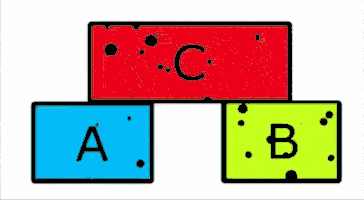
Zeroth law of thermodynamics states that
“If two bodies A and B are in thermal equilibrium with third body C, then body A and B are also in thermal equilibrium with each other.”
I know this may seems little bit difficult to you. So let me explain you in simple way.
As shown in the above figure, consider three bodies A, B and C having different temperatures.
Let body A and B are separated from each other as shown in figure.
But each of them are in thermal contact with the third body C.
After some time, body A will come in thermal equilibrium with the body C and similarly body B will also come in thermal equilibrium with body C.
After this condition, if body A and body B are kept together in contact with each other (second figure), then there will be no heat exchange between the body A and body B (because body A and body B are at the same temperature). This indicates that body A and body B are now in thermal equilibrium with each other.
Mathematically, these situation can be represented as
If, Ta = Tc and Tb = Tc, then according to zeroth law of thermodynamics Ta = Tb. Where Ta, Tb and Tc are the temperatures of body A, B and C respectively.
Now I want to explain you the most important and real life example of zeroth law of thermodynamics.
You can refer more examples based on the 0th law of thermodynamics from this article – “Examples of zeroth law of thermodynamics in real life“
Keep reading!!!
From the zeroth law of thermodynamics we found that there is one physical property that indicates whether the bodies are in thermal equilibrium or not. And that property is Temperature.
In simple terms, we can say that the zeroth law of thermodynamics helps us in finding the temperature of the body.
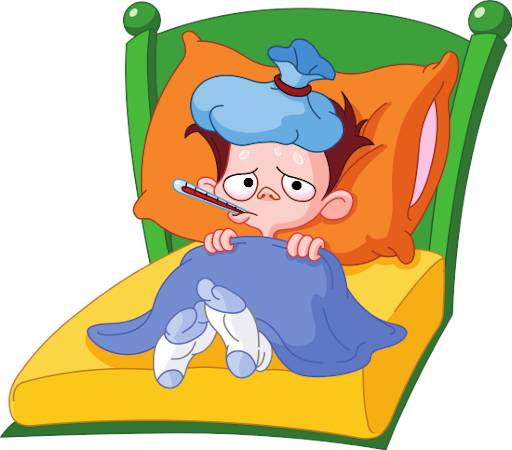
For example, when a thermometer is kept in contact with a human body, it achieves thermal equilibrium with the human body. At this condition, the temperature of the thermometer will be the same as the temperature of the human body. Thus in this way, the zeroth law of thermodynamics is used to find the body temperature using a thermometer.
Don’t get bored guys, more amazing topics are coming on the way.
Phase diagram and triple point
Phase?
Diagram?
The diagram showing phase is called phase diagram. lol…
Just kidding!!!
But the actual meaning is somewhat similar to this.
Now, you might have heard about solid, liquid and gas. What are they?
They are the phases of a matter. Right !!!
Now phase diagram is nothing but a graph of pressure vs temperature which shows the phase of matter at a given temperature (T) and pressure (P).
Here, you will exactly come to know what is phase diagram and its graph in brief.
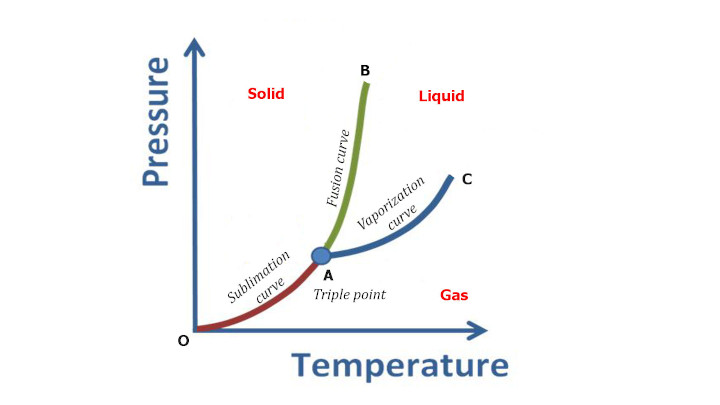
As shown in the image, three phases solid, liquid and gas are shown and they are separated by three lines.
Fusion curve (or melting curve or freezing curve)
AB line indicates that the solid phase and liquid phase are in equilibrium. And this line is known as the Fusion curve.
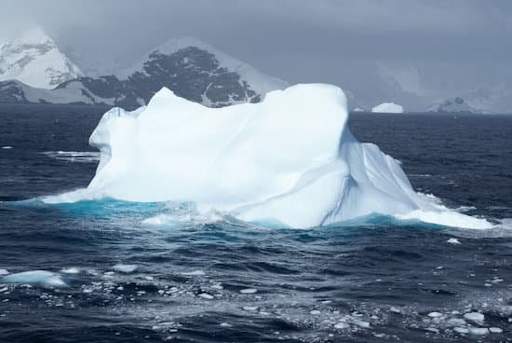
I’ll explain to you the practical example of solid-liquid equilibrium. The above image shows the ice and water in equilibrium state. Neither ice is melting nor water is converted to ice. This curve is also known as melting curve or freezing curve.
This is amazing. Right? Let’s move further.
Vaporization curve (or condensation curve)
AC line indicates that the liquid phase and gaseous phase are in equilibrium. And it is known as the vaporization curve. (It’s simple, because we know that when water is converted to vapor, we call it as vaporization. And here liquid and gaseous phase are in equilibrium with each other)
Let us see one example.
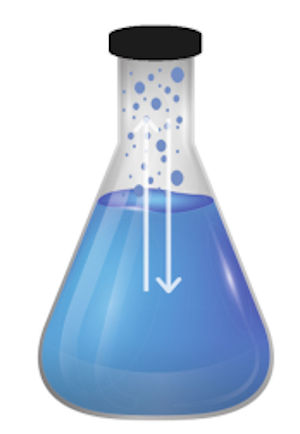
You can see in the image that water and vapor both are in equilibrium with each other.. Such a phase is represented as a vaporization or condensation curve on the phase diagram.
Sublimation curve (or deposition curve)
OA line indicates that solid and vapor states are in equilibrium with each other. This curve is known as the sublimation curve.
But do you know what is sublimation?
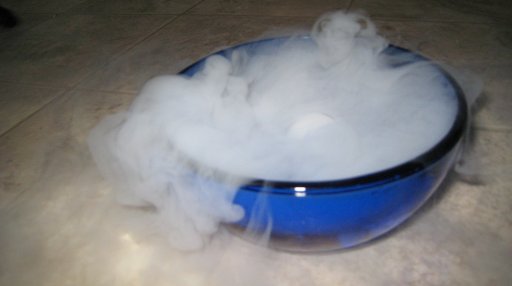
Sublimation is nothing but a conversion of solid state directly to the vapor state.
You might have seen that when we ignite the camphor, it gets converted to vapor. The above example is of Dry ice. Dry ice is in solid-state, but it gets directly converted to a vapor state. It does not melt, but it directly evaporates. Such a phenomenon is called sublimation.
Thermodynamics is Amazing!!!
Triple point
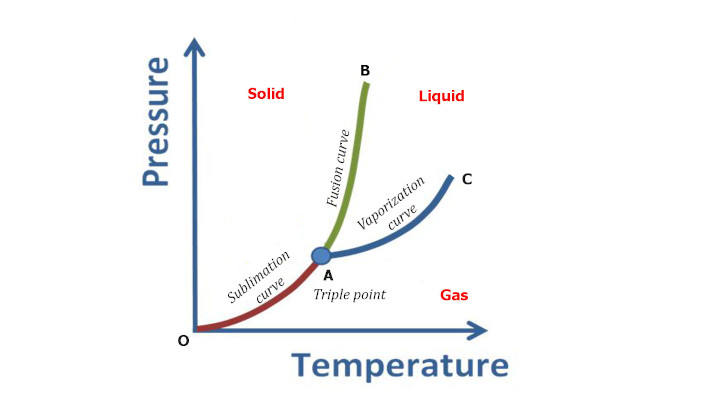
This is really interesting. Isn’t it?
Have you ever seen any object in solid, liquid and gaseous state at a same time?
In the above image, the pressure vs temperature curve of pure water is given. The water is in solid-state, liquid state as well as gaseous state and that also at the same time. OMG!!!
But, this situation occurs at particular temperature and pressure.
Now, let us frame the definition of triple point.
Triple point: The temperature and pressure at which all the three phases of matter i.e solid, liquid and gas exist in equilibrium with each other is known as triple point of that matter.
The triple point of water is obtained at the pressure of 4.58 mm Hg and 273.16 K temperature. Triple point of water is used to fix the scale of thermometer.
I hope you have understood the concept of phase diagram and triple point in a better way. Now lets move to the next topic.
Thermal expansion
The principle of thermodynamics are present all around us.
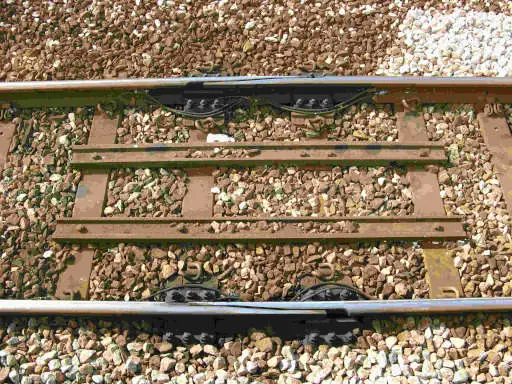
Have you ever noticed a gap between the rails?
Just try to think why this happens?
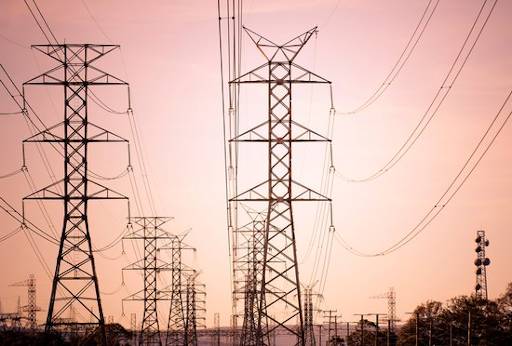
Have you seen something like this?
Why these electrical wires are sagging?
All this occurs due to thermal expansion.
Let me explain you with a simple example.
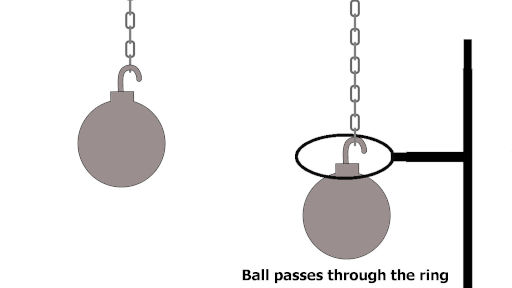
Here in the first image, you can see iron bob at room temperature. If we pass this iron bob through this ring, then it will pass easily as shown in the image.
Now heat this same iron ball with a burner and then pass this heated Bob through the ring.
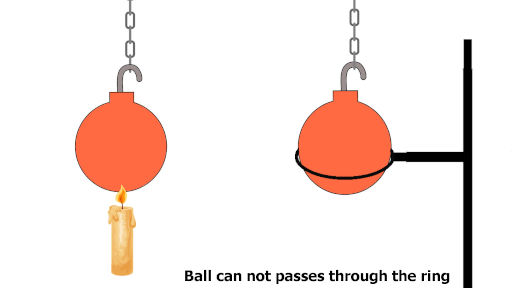
The heated Bob will not pass through the ring.
Why it occurs like this?
See, all the objects are made up of atoms and molecules. These atoms oscillate about their mean position. When the temperature rises, the atoms and molecules start to oscillate with a large amplitude. Because of this, the distance between the molecules increases which ultimately increases the dimensions of the object.
Hence, as the temperature rises, the size of object increases.
This is known as thermal expansion.
Thermal expansion: The increase in the dimensions of the object due to the absorption of heat is known as thermal expansion.
Thermal contraction: The decrease in the dimensions of the object due to the rejection of heat is known as thermal contraction.
There are three types of thermal expansion
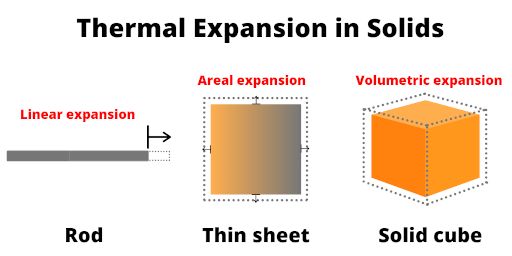
- Linear expansion: When the body expands linearly due to the absorption of thermal energy, it is known as linear thermal expansion.
- Areal expansion or superficial expansion: When a thin sheet of metal expands due to the absorption of thermal energy, it is known as areal thermal expansion of superficial thermal expansion.
- Volumetric expansion or cubical expansion: When the volume of the body increases due to the absorption of thermal energy, then it is known as volumetric thermal expansion or cubical thermal expansion.
Keep reading… Something interesting is coming now.
First law of thermodynamics | Heat, Internal Energy and Work
(Note: For detailed explanation on first law, refer this article: First law of thermodynamics with examples)
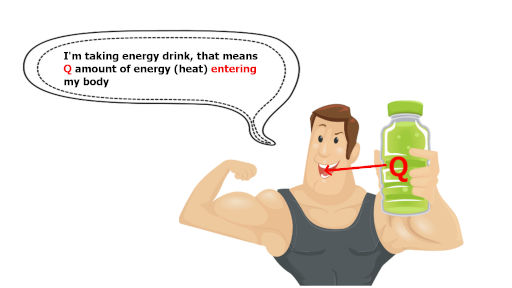
This boy is eating food and he gains Q amount of energy from the energy drink. So we can say that Q amount of energy is entering the body.
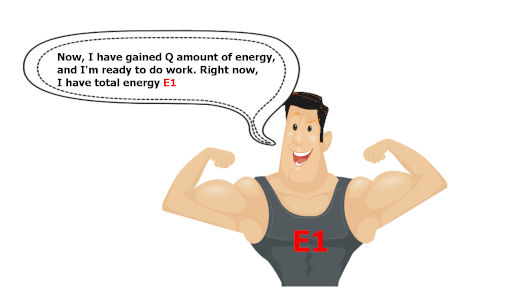
This image shows that this muscular boy has gained Q amount of energy and now he is ready to do work. And right now he is having total energy E1.
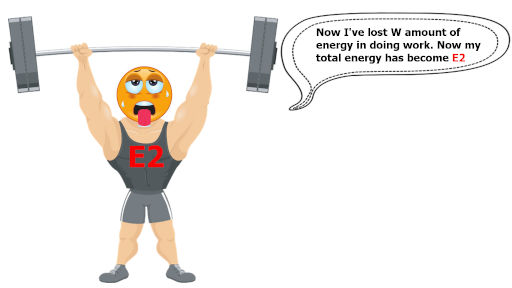
This boy spends W amount of energy in doing some work (here weight lifting). And his total energy becomes E2.
Now here,
Q = Inlet energy to the body
W = Outlet energy in the form of work
E1 = Total energy that boy is having during initial state
E2 = Total energy that boy is having during the final state
The body gains Q amount of energy and spends W amount of energy.
Hence the change in total energy of the body is given by Q – W.
Now, this change in total energy is nothing but E2 – E1.
Above statement can be mathematically written as;
E2 – E1 = Q – W
Therefore,
This equation is known as first law of thermodynamics.
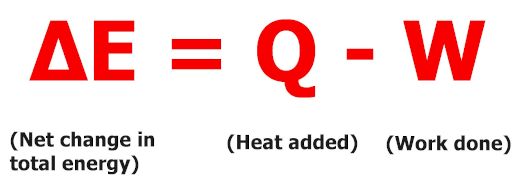
Now you will understand the statement of first law of thermodynamics very easily.
First law of thermodynamics: The net change in the total energy of a system (∆E) is equal to the heat added to the system (Q) minus work done by the system (W).
When the system gains heat (Q), it’s net change in total energy (∆E) increases. But when the work is done by the system(W), then the net change in total energy (∆E) decreases.
(It’s simple. Just refer the mathematical equation of first law of thermodynamics ∆E = Q – W. Here, if Q increases, then ∆E also increases and if W increases, then ∆E decreases)
Also read:
1). First law of thermodynamics examples and
2). Limitations of First Law.
What is Heat capacity and Specific heat?
Heat capacity
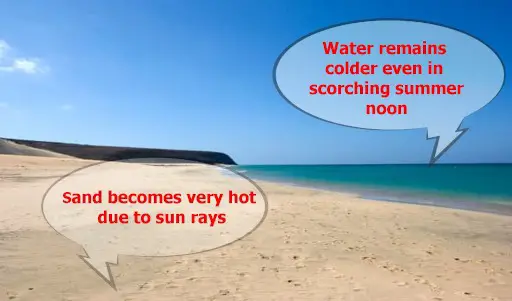
Both sand and water are receiving the same amount of sun rays (heat energy), then why there is a difference in the temperature of the sand and water?
Why this happens?
Yay, the concept of heat capacity plays the important role here.
I’ll explain you.
As shown in above picture, the sand gets heated more as compared to water.
We can say that, for heating the sand, only a few amount of heat is required. While for heating the water, a lot of heat is required.
In other words, sand is not having more capacity to absorb heat. While water keeps on absorbing the heat of the sun.
(Let me give you a funny example: A short-tempered person gets angry very soon. While a calm person who keep on tolerating everything will not become angry soon)
Heat capacity is something similar to this.
The amount of heat required for the same change in temperature, is different for different objects.
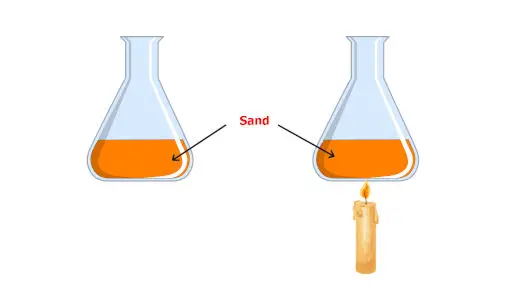
For example, take 1 kg of sand and right now it is at 20 °C. Now I want to increase its temperature to 25 °C. The amount of heat required to increase this temperature from 20 °C to 25 °C is say 1000 Joules.
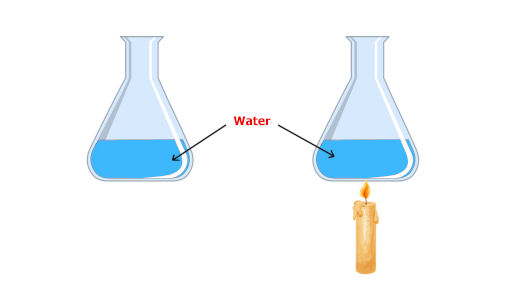
Now, take the same 1 kg of water in this bowl at 20 °C and increase its temperature to 25 °C using a burner.
Guess what will happen?
Will it consume more heat energy or less heat energy?
The answer is: Water will consume more heat energy compared to the same quantity of sand.
This happens because water has more capacity to absorb the heat.
Heat capacity (Hc): The ratio of heat supplied (Q) to the body to the change in its temperature ∆T is called heat capacity (Hc) of that body.
Hc = Q/∆T
Or
Heat capacity (Hc) is defined as the amount of heat absorbed (Q) in order to increase the temperature (∆T) by 1 unit.
How to remember this?
Just see this formula, Hc = Q/∆T.
In this formula of heat capacity, if ∆T is 1, then Q = Hc. Means heat absorbed or rejected (Q) is known as Heat capacity (Hc)]
The unit of heat capacity is J/K.
From the above example of sand and water, we noticed that the heat capacity of sand is less, while the heat capacity of water is more. That means heat capacity depends on the material of the body.
Also, one more thing I would like to add. Heat capacity also depends on the mass of the object. Bigger the mass of the object, more heat will be absorbed, so its heat capacity will be more. While smaller the mass of the object, less heat will be absorbed, so it’s heat capacity will be less.
Specific heat capacity or specific heat (C)
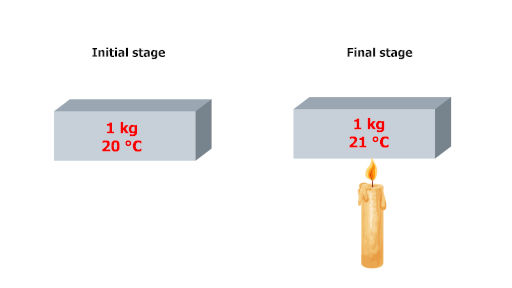
Everything is same as heat capacity, we just have to take a unit mass over here.
I will explain.
Just see the above picture, you can see the iron block having 1 kg mass and during the initial stage its temperature is 20 °C.
Now, on applying some heat, its temperature rises by 1 °C and it’s temperature becomes 21 °C.
During this phenomenon, the amount of heat supplied is known as the specific heat capacity of the body.
Let me give you a clear definition.
Specific heat capacity (C): Specific heat capacity (C) is defined as the amount of heat absorbed (Q) in order to increase the temperature (∆T) by 1 unit, of a unit mass(m).
C = Q/m∆T
In other words, if the mass of a body is unity, then the heat capacity of the body is known as specific heat capacity or specific heat.
How to remember?
Just see this formula C = Q/m∆T.
In this formula, if ∆T = 1 and m = 1, then Q = C. Means heat absorbed (Q) is known as Specific heat capacity (C)]
The SI unit of specific heat capacity is J/kg K.
Remember: The specific heat capacity of water is 4182 J/kg K.
Also see: Difference between heat capacity and specific heat capacity.
4 types of thermodynamic processes
Here I’ll explain the thermodynamic process in brief. Trust me you will enjoy this.
There are four types of thermodynamic processes.
Isobaric process
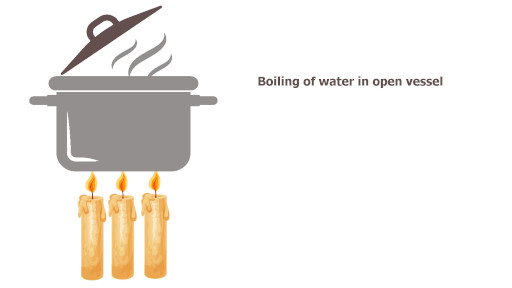
Have you seen this at your home?
I hope you have seen this. This is the boiling of water in open vessel.
The boiling of water takes place at atmospheric pressure only. The pressure neither increases nor decreases.
The thermodynamic process in which the pressure remains constant is called the isobaric process.
Isochoric process
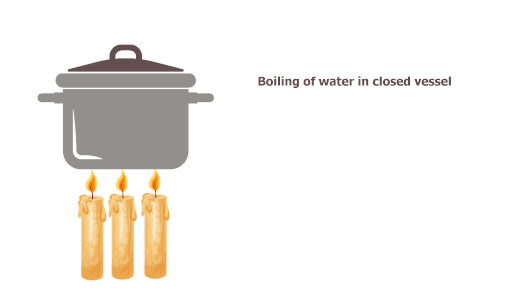
Hurray!!
Now I will close this vessel with the help of lid and then I’ll boil the water.
Have you done this funny things in your life…(let me know in the comments below)
Hehehe…who boils water in a closed cooker.
Well, in this process the vessel/cooker is closed, which means the volume of the vessel remains the same only. The volume is neither increasing nor decreasing.
Here the boiling of water takes place in some specified constant volume.
Thus,
The thermodynamic process in which the volume remains constant is called isochoric process.
Adiabatic process
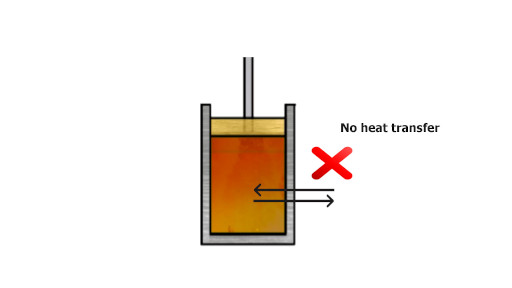
The thermodynamic process in which there is no heat transfer involved is called adiabatic process.
Let me give a simple example. Here is a piston and cylinder. The piston moves up and down, which means expansion and compression take place over here. But there is no heat exchange occurring between this system and surrounding (∆Q = 0). Thus this is an example of an adiabatic process.
Isothermal process
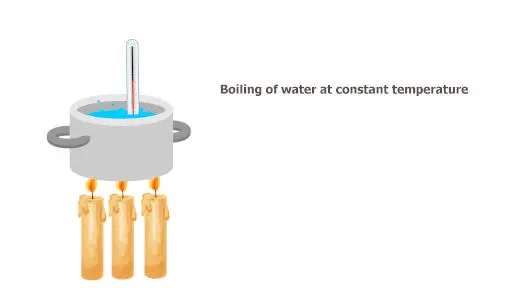
The thermodynamic process which occurs at constant temperature is known as an isothermal process.
You have already observed the boiling of water at your home. But I’ll tell you what exactly happens during this process.
As shown in the above picture, the water is boiling, but this process occurs at a constant temperature. You can see the thermometer reading remains constant only.
Reversible and irreversible process
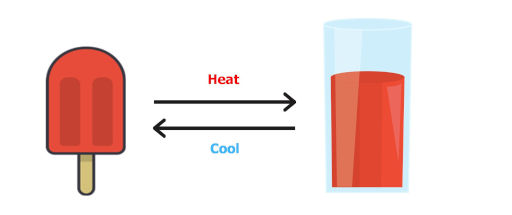

This ice cream can be converted to liquid on heating, and again it can be converted to ice cream on freezing.
Water can be converted to ice on freezing. And this ice can be again converted back to water on heating.
So, let me give you a definition of Reversible process in thermodynamics.
Reversible process: The thermodynamics process which can be reversed back to its original state is called reversible process.
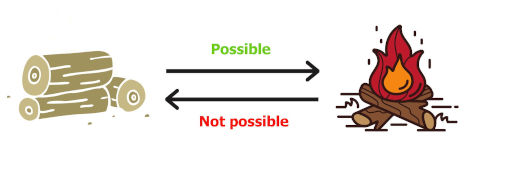
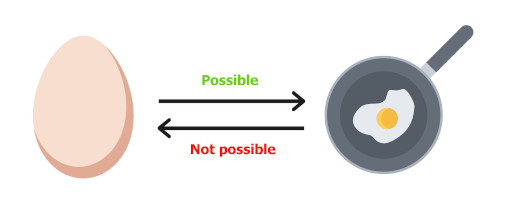
This wood can be converted to fire, but fire can not be again converted to wood.
Egg can be fried on applying heat. But fried egg can not be converted to the original egg on cooling it. (Do you eat eggs? Let me know in comments)
I hope you have got the idea of irreversible process.
Irreversible process: The thermodynamic process which can not be reversed back to it’s original state is called irreversible process.
Thermodynamics is really amazing and we can see it in our surroundings too.
Let’s move further now with a new topic.
Heat engine
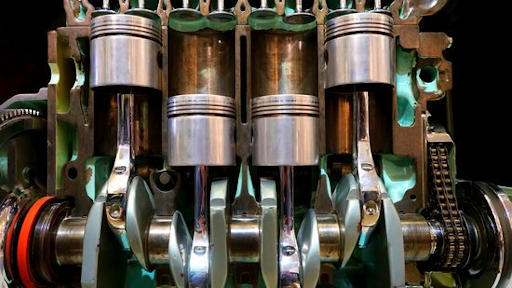
You might have seen such engine.
Just ask yourself, how this engine works?
.
.
.
.
.
.
Yes, it works with the help of fuel. The fuel burns inside the engine and produces heat. This heat is used to do some useful work.
Let me explain you with a simple diagram.
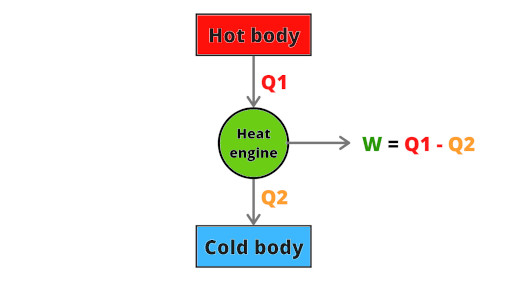
As shown in above figure, there are two bodies, hot body and a cold body.
Now, in the above discussion on heat transfer, I mentioned that heat transfer always takes place from hot body to cold body.
So here also heat will flow from hot body to cold body.
Let,
Q1 = Heat transferred from the hot body
Q2 = Heat received by the cold body.
Now, if we keep the engine between this hot body and a cold body, then work can be produced from this engine as heat flows from the hot body to the cold body.
Now, I’ll give you the short and simple definition of heat engine.
Keep reading.
Heat engine: Heat engine is a device which is used for producing the motive power from the heat.
Or
A heat engine is a machine or a device that converts heat energy into mechanical energy (work) by transfer of heat from high temperature to lower temperature.
Hey,
Do you know, in the above picture how much work can be produced by the transfer of heat Q1 and Q2 as shown in the picture.
Here, the total amount of work done by this heat engine will be;
W = Q1 – Q2
The unit of work done is same as the unit of heat, i.e Joule (J).
Are you enjoying thermodynamics?
Let me know in the comments section (I would be happy to know this)
Heat pump
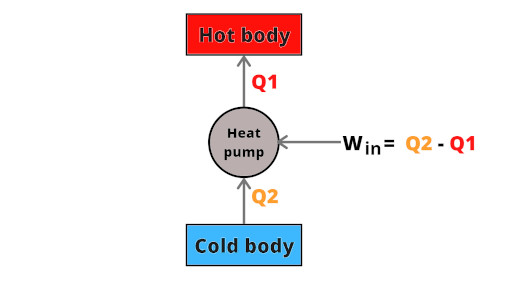
What is a heat pump in thermodynamics?
It easy, trust me.
Now look, in the heat engine we saw that heat transfer takes place from a higher temperature body to the lower temperature body and the device or machine produces some useful work. And that’s obviously right.
But what if we want to transfer the heat in the reverse direction? i.e from lower temperature body to higher temperature body.
Heat transfer never takes place from lower temperature to higher temperature on it’s own.
In this case a new device is use to do so, and this device is known as heat pump.
As shown in the above diagram, the heat pump extracts the Q1 amount of heat from the lower temperature body and delivers a Q2 amount of heat to the higher temperature body.
But will this heat transfer takes place on it’s own?
No.
We need to supply some work to this device in order to transfer the heat from lower temperature to higher temperature.
Let me give you a simple definition.
Heat pump: Heat pump is a device which is used to transfer heat from lower temperature to higher temperature by using mechanical energy.
Do you know, how much amount of mechanical energy is supplied in this heat pump for the transfer of heat from a lower temperature body to a higher temperature body?
The amount of mechanical energy required is;
W = Q2 – Q1
The unit of this work done is Joule (J)
Second law of thermodynamics
(Note: For detailed information read the separate article on second law of thermodynamics.)
I will explain you the simple definition of second law of thermodynamics.
The second law of thermodynamics includes two statements.
1). Kelvin Planck’s statement
2). Clausius’s statement
Kelvin Planck’s statement:

This picture will make you understand the Kelvin Planck’s statement very easily. Don’t worry, I m here to give you a clear understanding of Kelvin Planck’s statement.
Kelvin Planck’s statement:
“It is impossible to construct a device (operating in a cycle) which works on a single heat source and converts all of its heat completely into work”
Look, we know that heat transfer takes place from a higher temperature body to a lower temperature body.
But here there is no lower temperature body. We have only one higher temperature body. So heat transfer cannot take place in this case.
And thus, this heat can not be converted to some work without any heat transfer.
This is what Kelvin Planck’s statement of second law wants to say.
It’s easy. Right? (Let me know in comments, if you have any queries)
Now let me explain you Clausius’s statement.
Clausius’s statement:
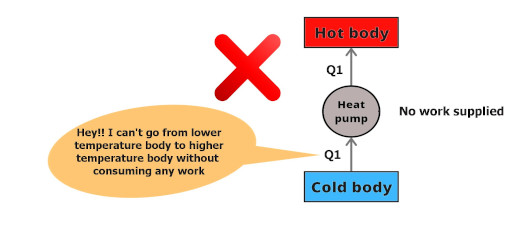
Its very easy to understand, just see the above picture. Heat Q1 is at a lower temperature body and it is saying that it will not travel to a higher temperature body without absorbing any heat.
Remember: Heat always flows from a higher temperature body to a lower temperature body. Its reverse flow does not take place on its own.
This is only the Clausius’s statement for second law of thermodynamics.
Here is a statement;
Clausius’s statement:
“It is impossible to construct a device (operating in a cycle) that can transfer heat from a cold body to the hot body without absorbing any work.”
Or
“Heat can not itself flow from colder body to a hotter body.”
Well, I know it is little bit complicated to understand thermodynamics second law. But don’t worry guys. Just read this topic again, and you will get a clear idea (hahaha…)
Also read:
1). Second Law of Thermodynamics examples and
2). Equation of Second Law of Thermodynamics.
Third law of thermodynamics
(For detailed explanation on Third law, refer this article: Third law of thermodynamics (Simple explanation))
Before starting the Third law of thermodynamics, I would like to explain two terms;
- Randomness
- Entropy
1) Randomness: The movement of molecules is known as randomness.

See this, how quite the students are sitting on their bench and they are not moving at all. This is exactly the situation when there is a strict teacher in your class. Isn’t it?

I guess this is the exact situation which is seen during the recess time.
Students are moving here and there in a classroom.
Now you will come to know what is randomness. See in the first image, the students are not moving, that means they are just sitting on their position. Thus, their randomness is zero.
But in the second figure, the students are moving here and there during recess time. This means that their randomness is more.
This is a simple concept of randomness.
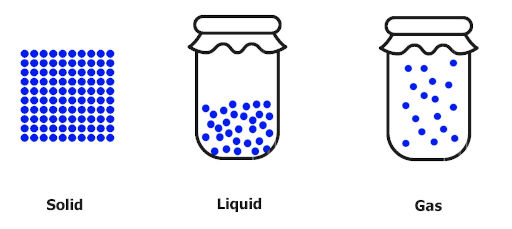
The same thing happens in solids, liquids and gases too. Solids show less movement of molecules, liquids have more movement of molecules and gases shows the maximum movement of molecules as shown in the above image.
This movement of molecules is known as randomness.
Thus we can say that solids have less randomness, liquids have more randomness compared to solids and gases have maximum randomness.
Now let’s move to Entropy.
2) Entropy: The measurement of randomness of the system is known as Entropy.
Or
Entropy is the measurement of disorder of the system.
It’s simple; it is just a measurement of how much randomly the molecules are moving in a system.
- In solids, the molecules are properly arranged, which means it has less randomness, so the entropy of solids is least.
- In gases, the molecules move very fast throughout the container. It has more randomness which means it has more entropy.
- The entropy of liquids lies in between the solids and liquids.
Third law of thermodynamics:
“The value of entropy of a completely pure crystalline substance is zero at absolute zero temperature”
I’ll explain you this definition/statement of third law of thermodynamics in a simple way. Don’t worry.
Tell me what happens when temperature increases?
Generally, as the temperature increases, the molecules vibrate with a greater speed, the oscillations increases, linear motion as well as rotational motion of molecules increases. Thus the randomness increases and it results in an increase of entropy.
Now, what happens when temperature decreases?
The answer is simple. Molecular vibration decreases, thus randomness of molecules also decreases and this results in a decrease of entropy.
The third law of thermodynamics states that, the value of entropy of the purely crystalline substance is zero at absolute zero temperature.
This means if we have a pure crystalline solid substance and if it’s temperature is absolute zero (0 K), then it’s entropy will be zero.
Summary (Read this if you are in hurry)
What is thermodynamics?
“Thermodynamics is a science that describes how thermal energy is converted from one form to the other and how it affects the matter.”
What is Temperature?
Temperature is a measurement of the average kinetic energy of the molecules in any object.
Or
Temperature can also be defined as a degree of hotness or coldness of an object.
What is heat?
Heat is defined as a flow of thermal energy due to differences in temperatures.
Heat is simply thermal energy in transit.
Concept of thermodynamic system and surrounding
Thermodynamic system: The system is defined as a part of the universe that is chosen for the thermodynamic study.
Surrounding: The region outside the system is known as surrounding.
Boundary: The actual or imaginary line which separates the system and surrounding is known as boundary.
Universe: The combination of system and the surroundings together is usually referred to as universe.
How heat transfer occurs?
The modes of heat transfer are mentioned below.
Conduction: Energy is transferred by direct contact.
Convection: The energy is transferred due to motion of molecules.
Radiation: The energy is transferred by electromagnetic radiation.
What is Thermal Equilibrium?
“The condition under which two objects in physical contact with each other exchanges no heat energy is termed as thermal equilibrium. During this condition, the temperature of both the bodies remains the same”
Zeroth law of thermodynamics
Zeroth law of thermodynamics states that
“If two bodies A and B are in thermal equilibrium with third body C, then body A and B are also in thermal equilibrium with each other.”
Phase diagram and triple point
Phase diagram: Phase diagram is nothing but a graph of pressure vs temperature which shows the phase of matter at a given temperature (T) and pressure (P).
Triple point: The temperature and pressure at which all the three phases of matter i.e solid, liquid and gas exist in equilibrium with each other is known as triple point of that matter.
Thermal expansion
Thermal expansion: The increase in the dimensions of the object due to the absorption of heat is known as thermal expansion.
First law of thermodynamics
First law of thermodynamics: The net change in the total energy of a system (∆E) is equal to the heat added to the system (Q) minus work done by the system (W).
What is Heat capacity and Specific heat?
Heat capacity (Hc): The ratio of heat supplied (Q) to the body to the change in its temperature ∆T is called heat capacity (Hc) of that body.
Hc = Q/∆T
Or
Heat capacity (Hc) is defined as the amount of heat absorbed (Q) in order to increase the temperature (∆T) by 1 unit.
Specific heat capacity (C): Specific heat capacity (C) is defined as the amount of heat absorbed (Q) in order to increase the temperature (∆T) by 1 unit, of a unit mass(m).
C = Q/m∆T
In other words, if the mass of a body is unity, then the heat capacity of the body is known as specific heat capacity or specific heat.
4 types of thermodynamic processes
There are four types of thermodynamic processes.
1). Isobaric process: A thermodynamic process in which the pressure remains constant is called isobaric process.
2). Isochoric process: A thermodynamic process in which the volume remains constant is called isochoric process.
3). Adiabatic process: A thermodynamic process in which there is no heat transfer involved is called adiabatic process.
4). Isothermal process: A thermodynamic process that occurs at constant temperature is known as isothermal process.
Reversible and irreversible process
Reversible process: The thermodynamics process which can be reversed back to its original state is called reversible process.
Irreversible process: The thermodynamic process which can not be reversed back to its original state is called an irreversible process.
Heat engine
Heat engine: Heat engine is a device which is used for producing the motive power from the heat.
Or
A heat engine is a machine or a device that converts heat energy into mechanical energy (work) by transfer of heat from high temperature to lower temperature.
Heat pump
Heat pump: Heat pump is a device which is used to transfer heat from lower temperature to higher temperature by using mechanical energy.
Second law of thermodynamics
Kelvin Planck’s statement:
“It is impossible to construct a device (operating in a cycle) which works on a single heat source and converts all of its heat completely into work”
Clausius’s statement:
“It is impossible to construct a device (operating in a cycle) that can transfer heat from a cold body to the hot body without absorbing any work.”
Or
“Heat can not itself flow from colder body to a hotter body.”
Third law of thermodynamics
“The value of entropy of a completely pure crystalline substance is zero at absolute zero temperature”
How do you feel about this article? let me know below in the comments section. I will surely reply to you.
Important Guides for you
(These guides have all the important knowledge about the laws of thermodynamics along with real life examples and lots more. You will love all these guides for sure.)
Also read:
- Zeroth law of thermodynamics
- What is First law of thermodynamics?
- First law of thermodynamics definition/statement (In simple way)
- Examples of First Law of Thermodynamics / Law of conservation of Energy
- First law of thermodynamics equation (A practical explanation)
- Limitations of First Law of Thermodynamics
- What is second law of thermodynamics? [8+ Best examples to remember the law]
- Examples of Second Law of Thermodynamics (8+ best examples)
- Second Law of Thermodynamics Definition/Statement (Next level explanation)
- Second Law of Thermodynamics Equation [Practical explanation]
- What is Third law of thermodynamics? (in simple terms)
- Laws of thermodynamics
- What is Carnot Cycle in Thermodynamics?
- What is the definition of entropy in thermodynamics?
- Heat capacity vs specific heat in thermodynamics
- What is Thermodynamic Equilibrium? (With Best Example)
- Thermodynamic Process (With Examples)
- What is Thermodynamic System? – Open, Closed & Isolated system (With Examples)
